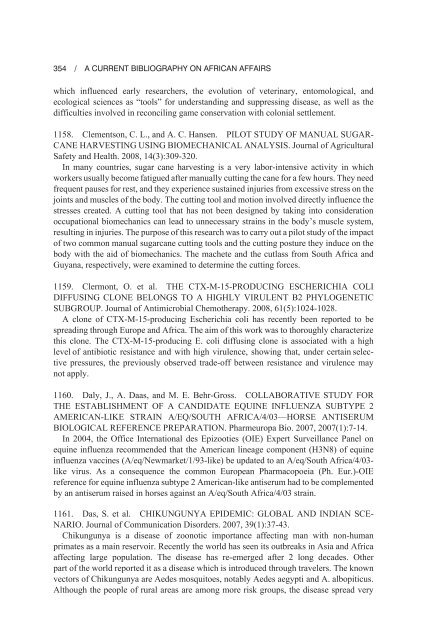A Current Bibliography on African Affairs - Baywood Publishing
A Current Bibliography on African Affairs - Baywood Publishing
A Current Bibliography on African Affairs - Baywood Publishing
You also want an ePaper? Increase the reach of your titles
YUMPU automatically turns print PDFs into web optimized ePapers that Google loves.
354 / A CURRENT BIBLIOGRAPHY ON AFRICAN AFFAIRS<br />
which influenced early researchers, the evoluti<strong>on</strong> of veterinary, entomological, and<br />
ecological sciences as “tools” for understanding and suppressing disease, as well as the<br />
difficulties involved in rec<strong>on</strong>ciling game c<strong>on</strong>servati<strong>on</strong> with col<strong>on</strong>ial settlement.<br />
1158. Clements<strong>on</strong>, C. L., and A. C. Hansen. PILOT STUDY OF MANUAL SUGAR-<br />
CANE HARVESTING USING BIOMECHANICAL ANALYSIS. Journal of Agricultural<br />
Safety and Health. 2008, 14(3):309-320.<br />
In many countries, sugar cane harvesting is a very labor-intensive activity in which<br />
workers usually become fatigued after manually cutting the cane for a few hours. They need<br />
frequent pauses for rest, and they experience sustained injuries from excessive stress <strong>on</strong> the<br />
joints and muscles of the body. The cutting tool and moti<strong>on</strong> involved directly influence the<br />
stresses created. A cutting tool that has not been designed by taking into c<strong>on</strong>siderati<strong>on</strong><br />
occupati<strong>on</strong>al biomechanics can lead to unnecessary strains in the body’s muscle system,<br />
resulting in injuries. The purpose of this research was to carry out a pilot study of the impact<br />
of two comm<strong>on</strong> manual sugarcane cutting tools and the cutting posture they induce <strong>on</strong> the<br />
body with the aid of biomechanics. The machete and the cutlass from South Africa and<br />
Guyana, respectively, were examined to determine the cutting forces.<br />
1159. Clerm<strong>on</strong>t, O. et al. THE CTX-M-15-PRODUCING ESCHERICHIA COLI<br />
DIFFUSING CLONE BELONGS TO A HIGHLY VIRULENT B2 PHYLOGENETIC<br />
SUBGROUP. Journal of Antimicrobial Chemotherapy. 2008, 61(5):1024-1028.<br />
A cl<strong>on</strong>e of CTX-M-15-producing Escherichia coli has recently been reported to be<br />
spreading through Europe and Africa. The aim of this work was to thoroughly characterize<br />
this cl<strong>on</strong>e. The CTX-M-15-producing E. coli diffusing cl<strong>on</strong>e is associated with a high<br />
level of antibiotic resistance and with high virulence, showing that, under certain selective<br />
pressures, the previously observed trade-off between resistance and virulence may<br />
not apply.<br />
1160. Daly, J., A. Daas, and M. E. Behr-Gross. COLLABORATIVE STUDY FOR<br />
THE ESTABLISHMENT OF A CANDIDATE EQUINE INFLUENZA SUBTYPE 2<br />
AMERICAN-LIKE STRAIN A/EQ/SOUTH AFRICA/4/03—HORSE ANTISERUM<br />
BIOLOGICAL REFERENCE PREPARATION. Pharmeuropa Bio. 2007, 2007(1):7-14.<br />
In 2004, the Office Internati<strong>on</strong>al des Epizooties (OIE) Expert Surveillance Panel <strong>on</strong><br />
equine influenza recommended that the American lineage comp<strong>on</strong>ent (H3N8) of equine<br />
influenza vaccines (A/eq/Newmarket/1/93-like) be updated to an A/eq/South Africa/4/03like<br />
virus. As a c<strong>on</strong>sequence the comm<strong>on</strong> European Pharmacopoeia (Ph. Eur.)-OIE<br />
reference for equine influenza subtype 2 American-like antiserum had to be complemented<br />
by an antiserum raised in horses against an A/eq/South Africa/4/03 strain.<br />
1161. Das, S. et al. CHIKUNGUNYA EPIDEMIC: GLOBAL AND INDIAN SCE-<br />
NARIO. Journal of Communicati<strong>on</strong> Disorders. 2007, 39(1):37-43.<br />
Chikungunya is a disease of zo<strong>on</strong>otic importance affecting man with n<strong>on</strong>-human<br />
primates as a main reservoir. Recently the world has seen its outbreaks in Asia and Africa<br />
affecting large populati<strong>on</strong>. The disease has re-emerged after 2 l<strong>on</strong>g decades. Other<br />
part of the world reported it as a disease which is introduced through travelers. The known<br />
vectors of Chikungunya are Aedes mosquitoes, notably Aedes aegypti and A. albopiticus.<br />
Although the people of rural areas are am<strong>on</strong>g more risk groups, the disease spread very




